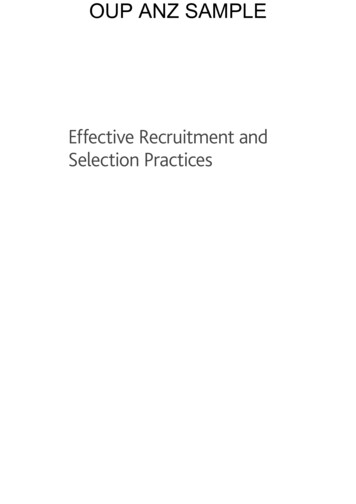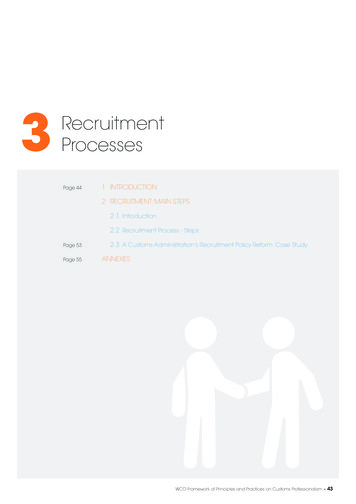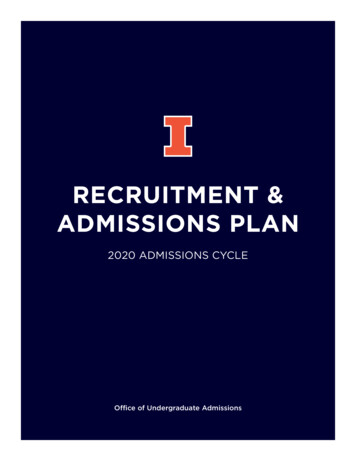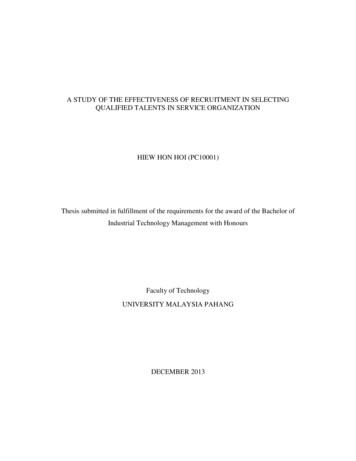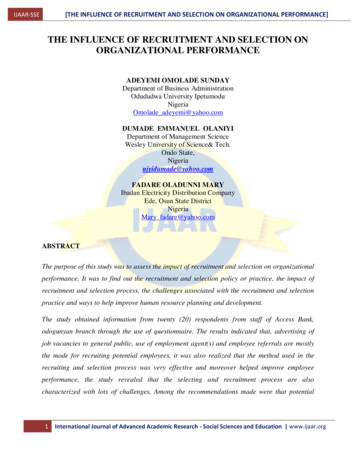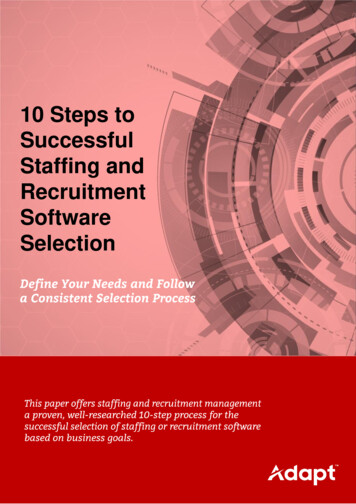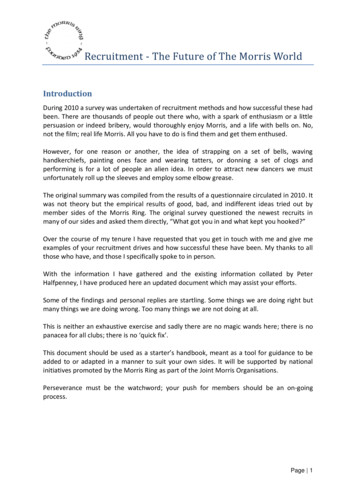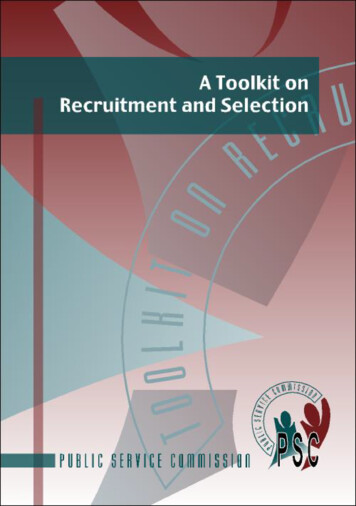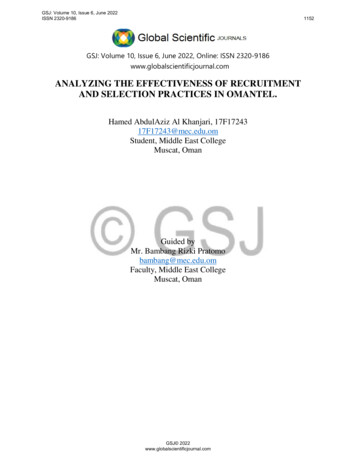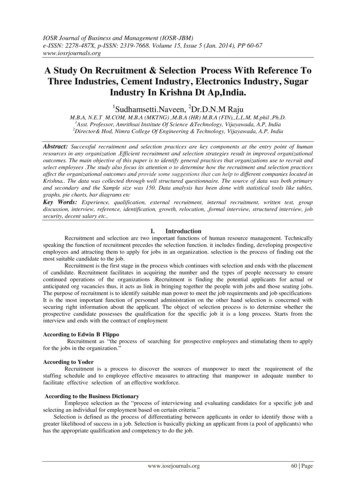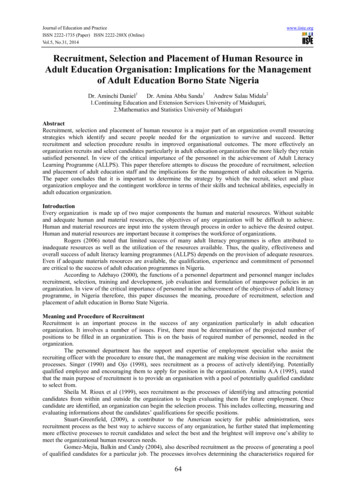
Transcription
Journal of Education and PracticeISSN 2222-1735 (Paper) ISSN 2222-288X (Online)Vol.5, No.31, 2014www.iiste.orgRecruitment, Selection and Placement of Human Resource inAdult Education Organisation: Implications for the Managementof Adult Education Borno State NigeriaDr. Aminchi Daniel1Dr. Amina Abba Sanda1Andrew Salau Midala21.Continuing Education and Extension Services University of Maiduguri,2.Mathematics and Statistics University of MaiduguriAbstractRecruitment, selection and placement of human resource is a major part of an organization overall resourcingstrategies which identify and secure people needed for the organization to survive and succeed. Betterrecruitment and selection procedure results in improved organisational outcomes. The more effectively anorganization recruits and select candidates particularly in adult education organization the more likely they retainsatisfied personnel. In view of the critical importance of the personnel in the achievement of Adult LiteracyLearning Programme (ALLPS). This paper therefore attempts to discuss the procedure of recruitment, selectionand placement of adult education staff and the implications for the management of adult education in Nigeria.The paper concludes that it is important to determine the strategy by which the recruit, select and placeorganization employee and the contingent workforce in terms of their skills and technical abilities, especially inadult education organization.IntroductionEvery organization is made up of two major components the human and material resources. Without suitableand adequate human and material resources, the objectives of any organization will be difficult to achieve.Human and material resources are input into the system through process in order to achieve the desired output.Human and material resources are important because it comprises the workforce of organizations.Rogers (2006) noted that limited success of many adult literacy programmes is often attributed toinadequate resources as well as the utilization of the resources available. Thus, the quality, effectiveness andoverall success of adult literacy learning programmes (ALLPS) depends on the provision of adequate resources.Even if adequate materials resources are available, the qualification, experience and commitment of personnelare critical to the success of adult education programmes in Nigeria.According to Adebayo (2000), the functions of a personnel department and personnel manger includesrecruitment, selection, training and development, job evaluation and formulation of manpower policies in anorganization. In view of the critical importance of personnel in the achievement of the objectives of adult literacyprogramme, in Nigeria therefore, this paper discusses the meaning, procedure of recruitment, selection andplacement of adult education in Borno State Nigeria.Meaning and Procedure of RecruitmentRecruitment is an important process in the success of any organization particularly in adult educationorganization. It involves a number of issues. First, there must be determination of the projected number ofpositions to be filled in an organization. This is on the basis of required number of personnel, needed in theorganization.The personnel department has the support and expertise of employment specialist who assist therecruiting officer with the procedure to ensure that, the management are making wise decision in the recruitmentprocesses. Singer (1990) and Ojo (1998), sees recruitment as a process of actively identifying. Potentiallyqualified employee and encouraging them to apply for position in the organization. Aminu A.A (1995), statedthat the main purpose of recruitment is to provide an organisation with a pool of potentially qualified candidateto select from.Sheila M. Rioux et al (1999), sees recruitment as the processes of identifying and attracting potentialcandidates from within and outside the organization to begin evaluating them for future employment. Oncecandidate are identified, an organization can begin the selection process. This includes collecting, measuring andevaluating informations about the candidates’ qualifications for specific positions.Stuart-Greenfield, (2009), a contributor to the American society for public administration, seesrecruitment process as the best way to achieve success of any organization, he further stated that implementingmore effective processes to recruit candidates and select the best and the brightest will improve one’s ability tomeet the organizational human resources needs.Gomez-Mejia, Balkin and Candy (2004), also described recruitment as the process of generating a poolof qualified candidates for a particular job. The processes involves determining the characteristics required for64
Journal of Education and PracticeISSN 2222-1735 (Paper) ISSN 2222-288X (Online)Vol.5, No.31, 2014www.iiste.orgeffective performance and then measuring applicant on these characteristics. Similarly Olalekan (2006), notedthat, the aim of recruitment is to attract qualified job candidates. He further stressed that in order to avoid wasteof fund, recruiting efforts should be targeted solely at applicant who have the basic qualification for the job.Recruitment individuals to fill a particular post within an organization can be done either internally byrecruitment within the firm or externally by recruiting people from outside internal recruitment could be done byencouraging the current employees to apply for the positions within the organization, such recruitment gives thestaff opportunity to move into firms of more desirable jobs, which may also create further openings that willrequire to be filled particularly adult education staff who are mostly on part time basis.According to Carble and Judge (1996), organizations use internal job posting and employee referral torecruit and these relatively easy and inexpensive ways to identify candidates both inside and outside theorganization. Internal job posting programme according to them, are also an excellent method of providingpromotion opportunities for employees and minimizing employee complains of unfair treatment anddiscrimination.Aminu (1995), noted that quite number of potential employees with the ambitions of changing theirjobs exist, but with the opportunity that most of the personnel department exploit is attempting to fill the vacantposition within the organization, by doing so it will help the organization to utilize their own personnel in fillingthe vacant positions before recruiting from outside the organization.The internal sources of recruitment can be done through any of the following:(i). Transfer(ii).Promotion(iii). Recalls from layoff and reorganization of the organizational chart and demotionRecruitment can also be done through external sources, in this; opening may be advertised on both printand electronic media as well as on the internet.External source makes it possible to draw a wide range of talent and provide the opportunity to bring new ideasand experience into adult education organization. According to Boone and Kurtz (1984), external recruitmentcan be done through:(i). Unsolicited Application(ii). Advertisement(iii). Employee Agencies(iv). Professional bodies and also through recommendation.External sources of recruitment are more costly, though the organization may end up with an employee whoproves to be effective in practice.Liberman (1959), Jenskinson and Neave (1980), and Brocke (1997), stressed on the effectiverecruitment of adult education staff, and further emphasised on the careful control over recruitment should beconsidered when recruiting adult education personnel.Similarly all Government of African countries including the Federal Government of Nigeria (2008),stated that recruitment of adult literacy personnel particularly the instructors was imperative in order to boast themoral of adult education staff in all African countries. This is because their target. There for employing themethod of recruitment in adult education organization as practiced in other sectors is important.SelectionSelection is part of the recruitment processes, it involves screening of candidates in order to identify from thosecoming forward, the individual must likely to fulfil the requirement of the organization. Torrington and Hall(1991), sees selection as one of the most difficult procedure of recruitment due to interest. Similarly Druker(2001), sees selection as the process that represent the final stage of the decision-making in the recruitmentprocess. He further explained that a wide range of technique is available to assist in carrying out selection whichinclude among others, the interview test and references.Selection as a process of screening of candidate may involves going into records, data sheet andcurricula vitae (CV).Testing may be introduced to examine the quality of human resources relevant to performavailable jobs or the task.According to Olulekan (2006), some of the tests usually used in selection of human resource are aptitude test,achievement, vocational interest and personality tests. The final stage of the selection process is what may becalled the decision and offer employment. Normally a decision is made to offer employment to the most suitablyqualified candidates after completion of the entire screening exercise.Hogan (1991), noted that selection findings indicate that more organizations with highly effectiveselection systems experienced higher employee outcomes. He further stated that organization with effectiveselection system appears better to identify and select employee with right skills and motivation and to succeed inavailable positions as well as in the organization.65
Journal of Education and PracticeISSN 2222-1735 (Paper) ISSN 2222-288X (Online)Vol.5, No.31, 2014www.iiste.orgPlacementPlacement is the process of putting people into certain position who have been selected for the job. Once a letterof employment has been given, the next stage is to place the newly recruited staff into their area ofspecializations. The professional adult education then take over to find out the area of the candidate’s skills andknowledge, can be suitable Egunyomi (2000), stressed that what is critical is that newly recruited candidatesshould be objectively placed in order to get the desire outcome.Most organizations placed their newly recruited staff on temporary and probationary appointment for aperiod of time usually for the period of one year, at the end of this period, appointment could be confirm if theperformance of the newly recruited staff is satisfactory, this should be applicable in adult education in Nigeria.Implications of Recruitments, Selection and Placement in the Management of Adult Education in BornState of Nigeria.Recruitment, selection and placement are processes that are critical to accomplishment of any organization goals.Therefore it is important to understand from the beginning that recruitment, selection and placement areactivities entrusted to the personnel department of the agency to take the final decision as to which candidatesshould be employed.Adult education in Nigeria need professionals in the field of adult education organization, and this canonly be done when the qualified personnel are recruited, following the same procedure and practices ofrecruitment, selection and placement in the other sector or organization.Policy on adult education learning programme (2003, emphasised on the provision of adequate human andmaterial resources in adult education organization, pointing out that the qualification and commitment of thepersonnel is important to the success of adult education in Nigeria. This is because employee’s talents andqualification always influences the effectiveness of any programme.Balami and Dibal (1997), also stated that an examination of these policies on mass literacy adult andnon-formal education reveals that adequate provision should be made for the recruitment and training ofpersonnel of the various organs of mass literacy delivery in Nigeria. They further stated that the functions of theorgans involves in the delivery of mass education in Nigeria are discharged through individual, and that whetherthese functions are discharged effectively, and the achievement of the objectives of such organs recordeddepends on the calibre of personnel who are pooled together and engaged in carrying out the functions assignedto the organs of adult education implementation in Nigeria.According to them the type of individual recruited to work for the organs and how their professionalcompetence is developed for discharging the responsibilities to the organs will affect the level of success that canbe achieved. There is need for employing professional and qualified personnel, for the progress of any adulteducation programmes depends largely on the personnel being recruited to the services, Wasam (1997).Adult education organization should therefore determine the type of test that is relevant to the kind ofrecruitment that will be suitable for the organization so that the right and qualified staff should be recruited andselected to fill the vacant post, so that the goals and objectives of adult education will be achieved, this isbecause there is no educational programme that can succeed without competent and qualified personnel.MethodologyA survey designed was used in this research work. The researcher interviewed 150 Adult literacy instructors 50each from the three senatorial district of Borno state. These hundred and fifty covers the whole state differentcentres of the Adult literacy sectors were interviewed in regards to how they rate the performance of these threefactors in their sectors as regard toStatistical Analysis RatingTable 1: Performance and Rating of Selection, Recruitment and Ranking1st2nd3rdThe table above described the statistical implication of the data collected during this research work.From the statistics, it is clear that frequency, percentage, mean and ranking was used to ascertain which of thispractice is having more priority as apply by the administrator of Adult literacy centre in Borno state. From theresult, this reveals that majority of the administrators have much interest in recruitment than selection andsubsequent placement in the mean as recruitment scored 376.5 with high rating percentage of 46.8% and a rank1st, followed by Selection with mean score of 33.8%, 2nd rank and placement has the least in all areas. From66
Journal of Education and PracticeISSN 2222-1735 (Paper) ISSN 2222-288X (Online)Vol.5, No.31, 2014www.iiste.orgongoing results, administrators have seems to be the root of some major problems associated with theorganization as they pay no much interest in following duly the process of good recruitment, which requires thatselection have to be made first before recruitment, and then placement.Figure 1;Figure 1 above describes the graphical representation of the nature and behaviour of the data. From thefigure it can be seen that recruitment have the highest points then followed by selection and then placement.ConclusionRecruitment, selection and placement are processes that are critical to the accomplishment of any task of anyorganizations. Appointment of qualified and competent personnel’s appointment through the diligent observationof fair and transparent procedure ensure the success of organization. This is because once the procedure ofrecruitment, selection and placement has been adopted in the sector; it will motivate the adult educationemployee.Better recruitment and selection procedure results in improved organizational outcomes. The moreeffectively organization recruitment and selections of candidates is, the more likely they are to hire and retaineffective personnel. Therefore, the starting point to improve adult education is to get qualified and interestedstaff through competitive fair and objectives recruitment and selection procedure.ReferencesAdebayo, (2004). Power in politics Ibadan: SpectrumAminu A.A, (1995). Personnel Management (i). Mainasara printing Press.Balami Y.G and Dibal (1997). Issues Related to Building Adult Education InstitutionalCapacity in Nigeria. In Fajonyomi A.A & Idowu Biao. policy issues in Adult Education and CommunityDevelopment Maiduguri Manasara: Ibadan publishers Press.Boone and Kurtz, (1984). Principles of Management in Aminu A.A Personnel Management Vol. (ii).Bratton J. et-al (1999), Human Research Management Macmillan,Drucker (2001), Management task, responsibilities practices. New York:, Harper and Row.Egunyomi D. (2000), Introduction to personnel Management Ibadan Holad Publisher:Fan (2008). National Policy on Adult Education. All African Countries. www.edu.learning.comLiberman et al (1980). The Friston Report. An Inquiry into Professional in Transition of Higher Education.Review Vol. (i).67
Journal of Education and PracticeISSN 2222-1735 (Paper) ISSN 2222-288X (Online)Vol.5, No.31, 2014www.iiste.orgGomze-Mejia, Balkin and Cardy (2004), Managing Human New Jersey, Pearson Educational Institution.Rogers. A. (2006) ASPBAE. Resourcing for Quality Education and Development HZDV.Hassan M. (2005), Educational Policy Decision & Information Technology: The need to find out fast journal ofgeneral studies Education Vol. (i).Stuart Greenfield (2009), Community Action, Inc. Employment recruitment and selection procedure.Olulekan M. (2006), Elements of Personnel Management.Ojo et al (1988), Personnel Management, Theories and IssuesSinger (1990), Human Resources Management, Boston PWSKENTShiela M. Rioux et al (1999), Survey Report of Recruitment and Selection Practice.Http/www. The times100.co.uk.Torrington D. and Hall (1991). Personnel Management, :A new approach. Practice Hall. International UK .html.68
The IISTE is a pioneer in the Open-Access hosting service and academic eventmanagement. The aim of the firm is Accelerating Global Knowledge Sharing.More information about the firm can be found on the homepage:http://www.iiste.orgCALL FOR JOURNAL PAPERSThere are more than 30 peer-reviewed academic journals hosted under the hostingplatform.Prospective authors of journals can find the submission instruction on thefollowing page: http://www.iiste.org/journals/ All the journals articles are availableonline to the readers all over the world without financial, legal, or technical barriersother than those inseparable from gaining access to the internet itself. Paper versionof the journals is also available upon request of readers and authors.MORE RESOURCESBook publication information: http://www.iiste.org/book/IISTE Knowledge Sharing PartnersEBSCO, Index Copernicus, Ulrich's Periodicals Directory, JournalTOCS, PKP OpenArchives Harvester, Bielefeld Academic Search Engine, ElektronischeZeitschriftenbibliothek EZB, Open J-Gate, OCLC WorldCat, Universe DigtialLibrary , NewJour, Google Scholar
Recruitment, selection and placement of human resource is a major part of an organization overall resourcing strategies which identify and secure people needed for the organization to survive and succeed. Better recruitment and selection procedure results in improved organisational outcomes. The more effectively an
